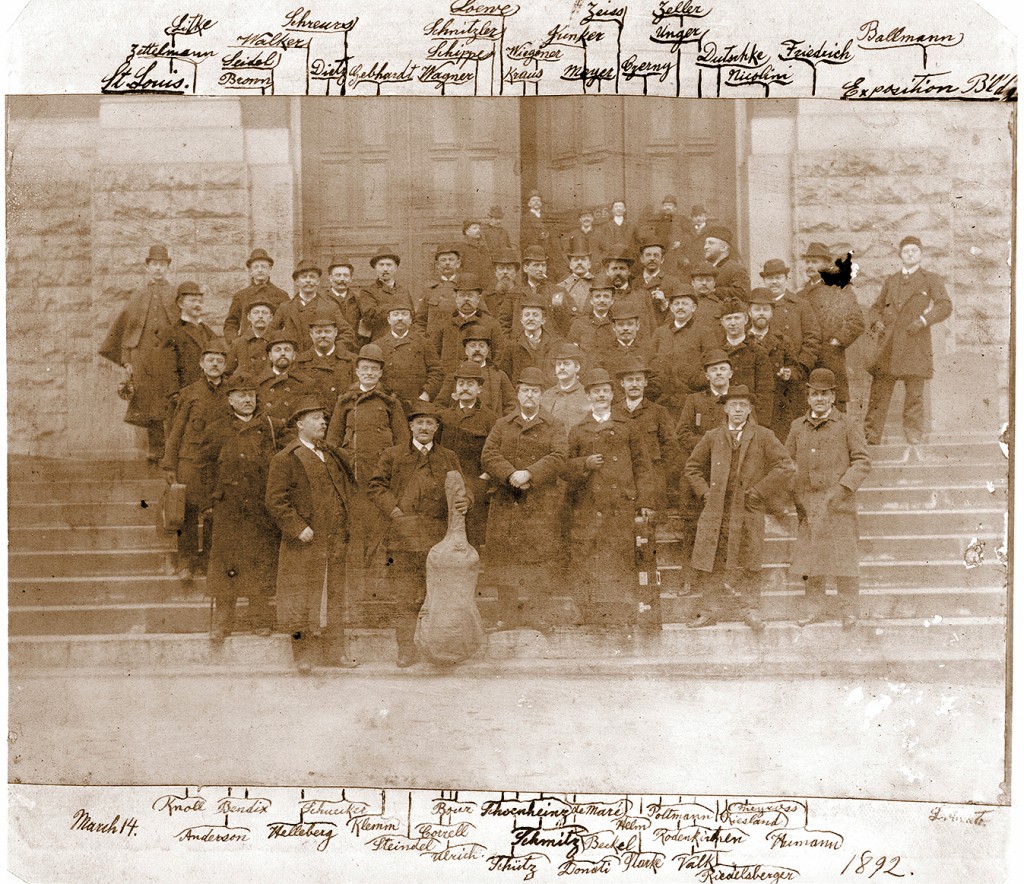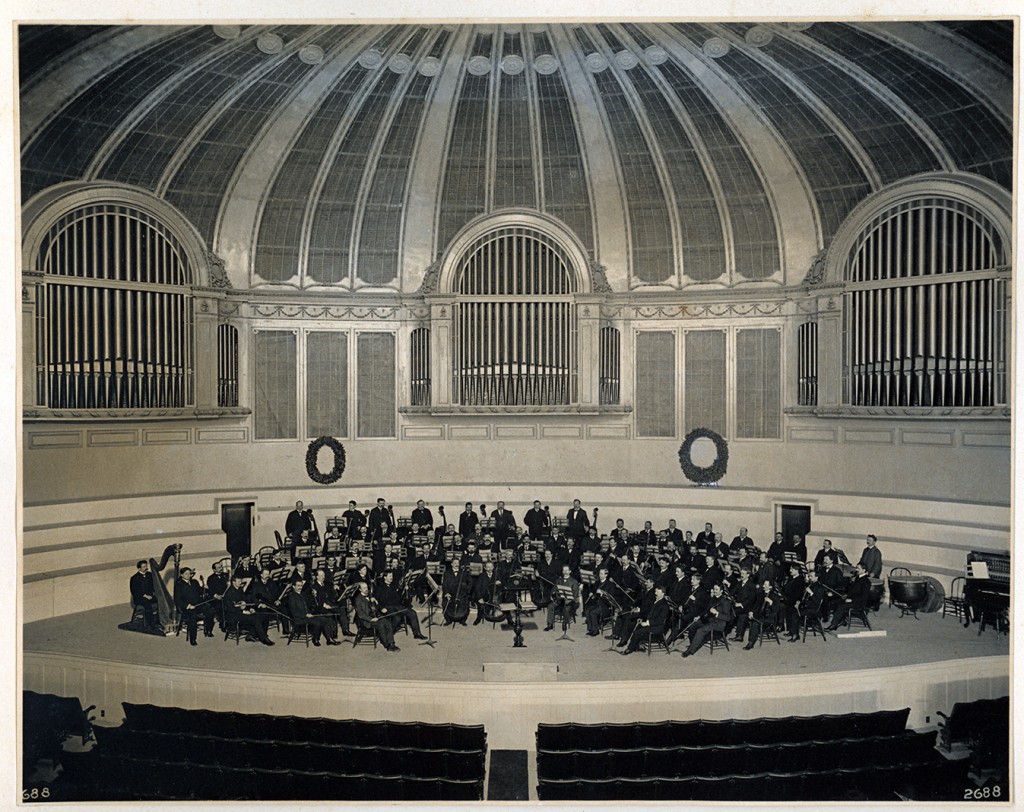
The image on the cover of the Chicago Symphony Orchestra’s program book for September-October is a detail from the earliest known photograph (see above) of the CSO onstage — then called the Chicago Orchestra — with its founder and music director, Theodore Thomas, on the podium. Based on the identification of the players, it appears to have been taken in late 1897. (Frederick Stock, who joined the orchestra as a viola player in 1895 and who would eventually succeed Thomas as music director, is seated in his section, directly to the right of Thomas’ raised right hand.) The setting is Louis Sullivan’s Auditorium Theatre, where the Chicago Orchestra played its first concert, on Oct. 16, 1891, and which continued to serve as its downtown home until Orchestra Hall was built in 1904.

Members of the Chicago Orchestra (as the CSO was then known) pose on the steps outside the St. Louis Exposition and Music Hall in 1892.
There is one earlier photo of the orchestra, taken in St. Louis in March 1892, when it was on tour during the first season. The shot was apparently taken on the spur of the moment. The players are casually posed on the steps outside the St. Louis Exposition and Music Hall, in topcoats and hats (typically for the late 19th century, there is not a bare head among them). Some of them are carrying their instrument cases, as if they have just finished rehearsing for that evening’s concert. Thomas does not even appear with his musicians.
Two months after the St. Louis photo was taken, Thomas and the Chicago Orchestra gave the U.S. premiere of Bruckner’s magnificent Te Deum, which Riccardo Muti and the Chicago Symphony Orchestra, with the Chicago Symphony Chorus, will perform in June to close the orchestra’s 125th season. It will be the finale of a season-long retrospective of works the CSO has premiered over the years. Week after week in the months ahead, the CSO’s programs will take audiences back to historic nights when the orchestra introduced important new scores to the public. It is a way of connecting with the CSO’s storied legacy over the years — of bringing alive the achievements of these musicians from times long gone and of finding a link between the photographs pulled from the vault of the CSO’s Rosenthal Archives — and the age of the selfie.
Since its founding in 1891, the orchestra has presented more than 650 U.S. and world premieres — a figure matched only by the New York Philharmonic and the Boston Symphony Orchestra, both of which started giving concerts earlier. Introducing symphonic music — particularly the classics of the repertoire that had not yet been played in America — was one of the Chicago Orchestra’s defining missions. Thomas was already famous as a champion of presenting unknown pieces to the American public long before he came to Chicago. (He gave the U.S. premiere of Wagner’s Flying Dutchman Overture for his debut as a conductor in New York in 1862!) As Rose Fay Thomas, his wife, wrote, “Thomas made it a principle, from the very start of his career, to play all the new music that was worthy of a place on his programs, as fast as it was composed and he could arrange for its performance. It was a matter of pride with him to be the first to play, in America, every important work, and sometimes he was able even to anticipate Europe in the matter.”
The Chicago Orchestra became his dream vehicle, late in a formidable career, for showcasing famous music that most Chicagoans had not yet had the chance to hear — and for championing brand-new, untested music as well. “The people cannot read new scores for themselves, as they read new books,” he said. “It is therefore one of the missions of a symphony orchestra to perform for them the current musical literature.”

Members of the Chicago Orchestra take the stage of Orchestra Hall, shortly after the building’s official opening on Dec. 14, 1904.
Many of the works the Chicago Symphony Orchestra premiered — first under Thomas, and then later by his successors as music director, beginning with Stock — are now universally known as landmarks. This season, as a way of celebrating the Chicago Symphony’s rarefied place in history, the orchestra will play several of the most important ones: Strauss’ Till Eulenspiegel’s Merry Pranks and Ein Heldenleben, Bruckner’s Ninth Symphony, Debussy’s Gigues, Holst’s The Planets, Elgar’s Enigma Variations, Sibelius’ Second Symphony, Prokofiev’s Third Piano Concerto, Bartok’s Second Piano Concerto — all cornerstones of the repertoire that the orchestra introduced to this country. The CSO also will reprise works that were commissioned by this orchestra and given their world premieres in Chicago, including Stravinsky’s iconic Symphony in C and Lutosławski’s Symphony No. 3, now considered one of the masterpieces of our time. Under Muti’s baton, it will introduce a work commissioned from one of the CSO’s new Mead Composers-in-Residence, Elizabeth Ogonek. (A commissioned work by Samuel Adams, the CSO’s other resident composer, will be premiered the following season.) The CSO’s 2015-16 premiere retrospective spans the orchestra’s entire history — from Bruckner’s Te Deum, given its U.S. premiere during the first season, to Ogonek’s world premiere next February.
A parting word about photographs of the orchestra through time. The only other surviving early photos of the Chicago Symphony Orchestra all date from the 20th, not the 19th, century. The first of them captures a turning point in the orchestra’s history. The setting is Orchestra Hall, the brand-new permanent home Thomas tirelessly campaigned to get built and dedicated on Dec. 14, 1904. But the podium is empty. Thomas had died on Jan. 4, 1905, perhaps only days before the now leaderless orchestra posed for its picture. The stage is hung with the holiday wreaths left over from the orchestra’s first Christmas in its new hall. Stock is still sitting in the viola section, although he had already jumped in to take over and conduct Thomas’ concert programs.
By the time the orchestra posed for the first of its official “class portraits” in February, Stock was now standing in front of his colleagues. (He was officially appointed music director in April.) There was one class photo taken nearly every year after that, each time with its current music director on the podium — a tradition that continues to this day. This past June, a few minutes after Tchaikovsky’s Manfred Symphony concluded one of the last concerts of the 2014-15 season, the musicians returned to the stage to be photographed with Riccardo Muti, only the tenth music director the orchestra has known in its 125 seasons.
A few footnotes: The 1892 photograph of the orchestra in St. Louis was unknown until sometime in the 1960s, when Jeff Gold, a Chicago freelance oboe player, discovered it in an antiques shop in Door County, Wis. I am indebted to Frank Villella, director of the CSO’s Rosenthal Archives, and to Norman Schweikert, CSO horn player from 1971 to 1997, for information regarding the orchestra’s historical photographs. Chicago Symphony Orchestra: 125 Moments, a celebration of the orchestra’s life over the past 125 years, illustrated with historic images from the CSO Archives’ collections, will be on display in Symphony Center throughout the season. For more information, please visit cso.org/125moments. The season-long retrospective of CSO premieres is underwritten by the Sargent Family Foundation.
Phillip Huscher is the program annotator for the Chicago Symphony Orchestra.